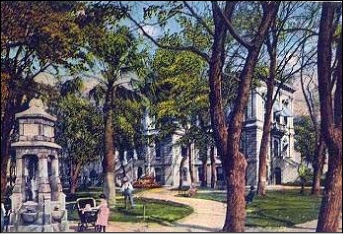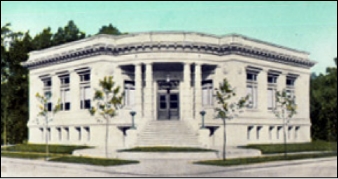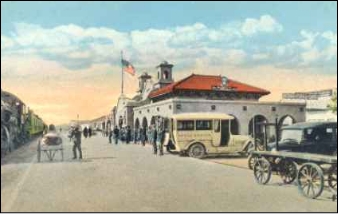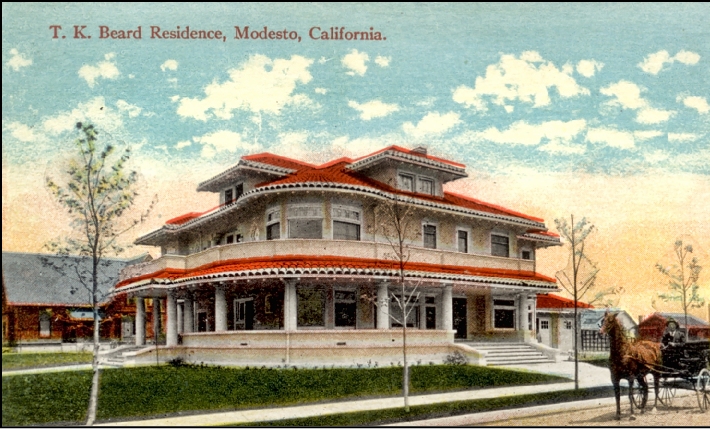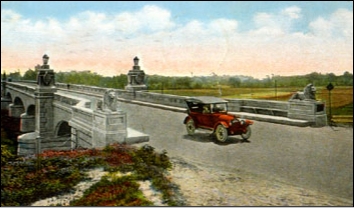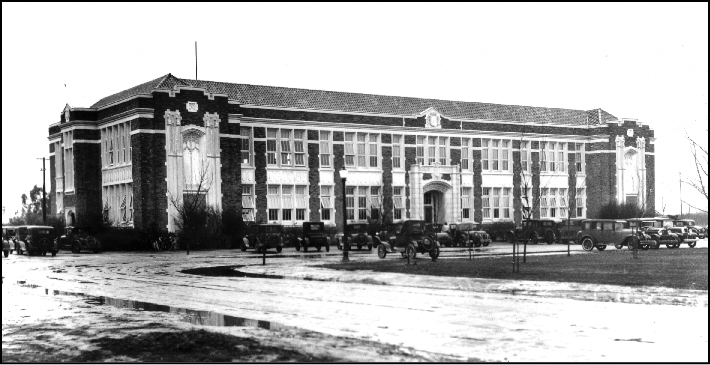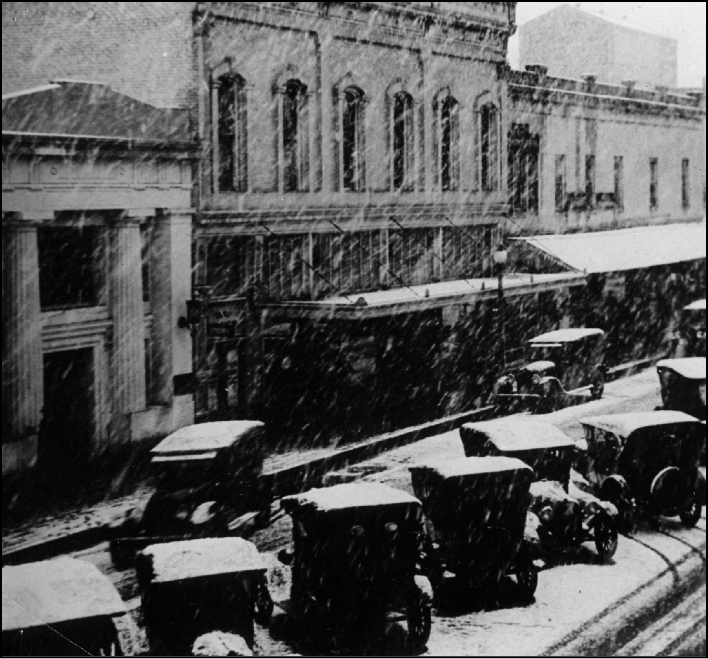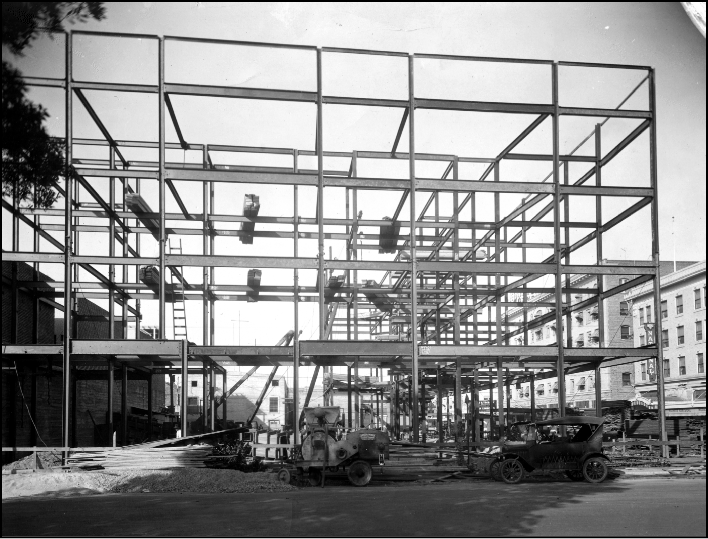20th Century Timeline - 1901 -1950 1901 - The Stanislaus County Courthouse gets a new Hall of Records.
- Modesto’s first high school building is completed at 12th and L Streets. Eighty-one students attend school there, including eighth graders.
1903 - I.E. Gilbert and Company General Store on the northeast corner of I and 10th becomes Schafer’s. It is underwritten by Oramil McHenry for his brother-in-law, George Schafer.
- First water flows through miles of MID canals to irrigate the fields of Stanislaus County.
1904 - The Modesto Irrigation District Jubilee is held April 21 – 22 to commemorate the opening of the irrigation canals. Trains take visitors from throughout the country on trips to see the irrigated fields of Stanislaus County. The city is ablaze with electric lights. California Governor and Mrs. George Pardee are in attendance.
- The First National Bank of Modesto is completed.
1906 - Oramil McHenry dies and his will bequeaths three 10th Street lots to the city plus $20,000 to build a library. The lots are sold and the library is built at a quieter location.
- Rogers Fountain is moved to Courthouse Park because of increased traffic at its former location in the intersection of 10th and I Streets.
1908 - Modesto Canning Company begins operation on 9th Street. In 1919, it is sold to Pratt-Low Preserving Company and later becomes Flotill, owned and operated by Tillie Lewis.
1910 - Modesto’s population is estimated at 4,034.
- Modesto adopts a new municipal charter.
- George E. Wallace is hired as Modesto’s first paid fire fighter because he is good with horses. He is appointed Fire Chief in 1911, a job he holds for 39 years.
1911 - Real Estate Agent George Wren is elected mayor under the city’s new charter.
- The Cressey Building, consisting of shops and apartments, is constructed on 10th near H Street.
1912 - The Modesto Businessmen’s Association completes construction of the iconic Modesto Arch. Erected at a cost of $2,000, the arch’s foundation is christened with canal water.
- Oramil McHenry’s bequest is realized when the McHenry Library is dedicated on April 29. The building is located at 14th and I Streets.
- A fire destroys the Modesto Creamery building. The Milk Producers Association of Central California purchases the 9th Street site in 1918.
1913 - The Modesto Theatre on 10th Street opens with a production of Gilbert and Sullivan’s The Pirates of Penzance, produced by the Modesto Chorale Company.
- Modesto’s new St. Stanislaus Church is built in a Spanish mission style on 7th and J Streets.
1914 - The Hotel Hughson and Hotel Modesto give Modesto two new opulent options for travelers and residents.
- James Apartments on I Street near the library are advertised as “strictly new.”
- Thomas K. Beard’s house at 102 Sycamore is built. Beard is founder of the Modesto and Empire Traction Company and an MID director from 1901 – 1907.
- Interior of Modesto Theatre is gutted by fire, but owner William B. Mensinger immediately rebuilds.
1915 - Southern Pacific opens a new train station at the foot of J Street, across Ninth. The building matches St. Stanislaus Catholic Church’s Spanish mission style.
1917 - Production of Borden’s Condensed Milk begins at the Borden Condensary Plant.
- The Seventh Street Bridge, or “Lion Bridge,” is dedicated on March 22.
1918 - A new campus for Modesto High School opens at H and 1st Streets with 545 students and a cost of $160,000. The campus remains in use today.
1919 - William W. Higgins establishes the Modesto Band, later known as “MoBand.” Francesco Nicolo “Frank” Mancini takes over leading the band when Higgins dies in May 1922.
1920 - Modesto population is 9,241.
- Modesto celebrates its 50th anniversary.
1921 - Modesto Junior College is founded under a new California act that establishes independent junior colleges. It is the first such institution in the state. The first junior college student to transfer moves from MJC to Stanford in 1922.
- Modesto’s flying ace, Harold “Bud” Coffee, and three others, including Giocondo Jacuzzi, die in a fiery airplane crash near Maze Wren Park on July 14.
- The resplendent Strand Theatre opens on 10th Street with The Mark of Zorro. Frank Mancini is a member of the grand opening orchestra and decides to stay in Modesto.
1922 - A snow blizzard hits Modesto
- Black Building constructed for $100,000 on I Street at 11th.
- Modesto and Turlock Irrigation Districts dedicate Don Pedro Dam on June 25.
1924 - George and Grace Covell open their upscale 70-room hotel at the corner of 11th and J Streets. The Hotel Covell is in the same block as the Hotel Hughson, and contains a movie theatre known variously as the Richards, National, Princess, and Covell.
1925 - Construction starts on the Beaty Building. Tenants begin occupying in March 1926. The building is one of the only remaining 1920s structures in Modesto.
1929 - A new section is added to the Hotel Covell, bringing the number of rooms to 128.
1930 - Modesto population is 13,842.
1931 - First performance of the Modesto Symphony Orchestra. Frank Mancini, Malin Longstroth, and Leonardo Fristrom founded the orchestra during 1929 – 1930.
1933 - Ernest and Julio Gallo open a small winery in Modesto with $5,900
- borrowed from Ernest’s in-laws, the Franzias.
- The Modesto Daily Evening News changes its name to The Modesto Bee and News-Herald.
- Harvey “Harve” Presnell, stage, film and television actor, is born in Modesto.
- The new Modesto Post Office opens in October at 12th and I Streets. Built by the WPA, the building’s lobby features hand-painted murals.
1934 - The art deco-inspired State Theatre, designed by famed architect S. Charles Lee, opens on December 25. First film is Flirtation Walk.
1936 - Carl Shannon home is completed on 17th and I Streets next to Shannon Funeral Home. Shannon serves as mayor of Modesto from 1939 – 1950.
1937 - The new Safeway grocery store opens on H Street.
1940 - Modesto population is 16,379.
1942 - First California Relays take place at the Modesto Junior College Stadium. The relays are an annual event until 2008.
- Hammond General Hospital, the largest military hospital on the west coast, opens in Modesto. Over 24,000 soldiers are treated there during World War II.
1944 - The Hotel Modesto is destroyed by fire on May 3. The ruins will remain fenced-in until the late 1950s when a new city hall is built on the site.
- George Lucas is born on May 14. Lucas will immortalize Modesto in American Graffiti in 1973 and launch the most successful film series in history with Star Wars in 1977.
1946 1947 - J.C. Penney Department Store is built in downtown at a cost of $750,000. J.C. Penney’s nephew, Richard E. Penney, is the store’s original manager.
1948 - President Harry S Truman speaks to a crowd during a September 23rd whistle stop at Modesto’s train station.
1950 - Modesto population is 17,389.
- Richard Nixon visits Modesto while running for Congress.
- Mark Spitz, Olympic gold medal swimmer, born in Modesto February 10. He and his family move to Hawaii when he is two years old.
Next: 20th Century/Timeline/1951 - 2000 Previous: 20th Century/Sports/The Relays |

